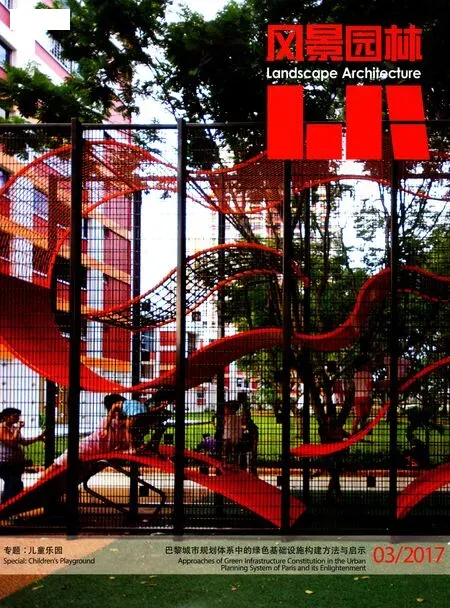东部公园攀爬游乐环
2017-06-22卡韦事务所比罗桑特恩可景观设计有限公司
卡韦事务所 比罗·桑特·恩可景观设计有限公司
东部公园攀爬游乐环
卡韦事务所 比罗·桑特·恩可景观设计有限公司
建于1891年的东部公园是阿姆斯特丹19世纪扩张时期的产物,同时也是第一个由政府组织建造的大型公共公园。风景园林师莱昂纳多·施普林格(Leonard Springer)设计了一个有着高大树木、蜿蜒小径和开阔池塘的英式古典风格城市公园。和其他公共公园相似,东部公园周边分布有众多城市公共服务建筑,如荷兰皇家热带学院(the Koninklijk Instituut voor de Tropen)、大学及北侧背向坐落的热带博物馆(Tropenmuseum)等纪念性建筑。
自2011年以来,设计团队一直致力于实现建筑与公园的融合,虽然该计划早在19世纪之初就有所体现,但却由于预算限制迟迟未能实现。从现状来看,栅栏和高台阶将纪念性建筑与公园隔绝。对此,桑特有限公司(Sant en Co.)作出了全新的设计,他们计划将公园延伸到建筑物周边,拆除原有栅栏,增加绿地面积,并将一部分私有区域作为公园公共空间向大众开放。最终,改造后的东部公园将实现公园规模的扩张及建筑与公园绿地的融合上的双赢。
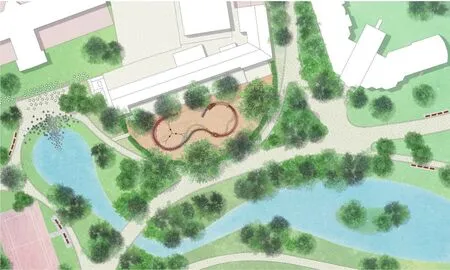
1 总平面图Site plan
除了规模扩张之外,公园在现有基础上也进行了改善,设计师增加新的道路以扩充现有的道路系统,同时翻新入口,拓展现有水体面积。至此,设计师将公园的新旧功能整合到现有公园中,使之与施普林格原有的设计相统一。
增设“攀爬游乐环”便是众多改善措施之一,游乐环坐落于一个露天学校对面、公园的西北角上一片先前不具备任何功能的草地上。88m长的攀爬游乐环是一个充满冒险气息的游戏设施,它时而上升、时而下冲、时而旋转形成狭窄的流线,其独特的造型围合出一个独立的内部空间。精妙的设计为这个玩乐空间开创了一个全新的局面。
为保证树冠和树根不受干扰,设计师利用高大的树木来确定游乐环的具体位置和形状。除此之外,设计师还作出了另一项革新:在这个项目中,摒弃了现代城市中广泛采用的人造安全垫面,取而代之的是自然材料制造的安全表面。沙子,作为这块场地最基础的游戏表面材料,将整个场地营造成了一个具有原始气息游乐场,在此基础上,游乐环作为遮蔽设施进行掩护,使沙子不容易被风吹走。另外,由于脆弱的树根仅能承载少量的外部荷载,游乐环的构造便需要保持轻盈,这种结构仅有几个位点与地面相接触,很大程度上减小了结构与树根接触的可能性。
这个简易的游乐设施吸引着孩子们在上面奔跑、攀爬和滑滑梯。因为构造本身有几个明显的抬高点,所以对于4~8岁儿童而言,这就像是一个极具挑战性的过山车。此外,游乐环本身具有很强的容纳能力,在最忙碌的时候,可以同时容纳超过100个孩子在游乐环的上面及周围玩耍。根据孩子们年龄差异和运动偏好的不同,设计师给游乐环赋予了多种多样的使用形式:陡峭部分的环体形成一个普通滑梯,而另一部分的环体又变化为管状滑梯,其中一个拱形构造下方放置着秋千,而另一部分的平台则被划分成两个不同的高度。在场地的入口,环体抬升形成一个 “拱”,直通环构造围合的内部空间。随着人们行进活动的变化,游乐环的形态也会因观察角度的不同而发生改变,该设计良好地激发了构造上部与下部、内部与外部空间之间的互动。
主流观点认为游乐设施的色彩应该尽可能丰富,但本设计试图结合双重思想:游乐环主要结构涂层的颜色与公园里其他的新元素色彩相一致——采用煤黑色。在此之上增加了两条色彩渐变的线,巧妙地将缤纷的色彩融合在这一长而连续的环形设施上,使游乐环像一道彩色的闪电贯穿整个公园,让人耳目一新的同时又不会过于抢眼。
(编辑/吴晓彤)
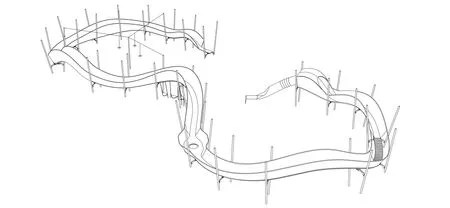
2 透视图Perspective view

3 88m长的攀爬游乐环The 88 meter long play garland
设计时间:2012—2015年
建成时间:2016年2月
客户:阿姆斯特丹市政府
项目区位:阿姆斯特丹东部公园
设计尺寸:88m长的环状游乐设施
设计团队:埃尔赫·比利茨,托马斯·蒂尔·格罗恩斯坦奇,卢卡斯·博凯尔, 贾斯伯·凡·德·沙夫,马克·凡·德·英格, 玛莲·比克
合作伙伴:比罗·桑特·恩可景观设计有限公司
摄影:卡韦事务所设计团队(玛莲·比克、贾斯伯·凡·德·沙夫)
翻译:罗雨薇
校对:王晞月
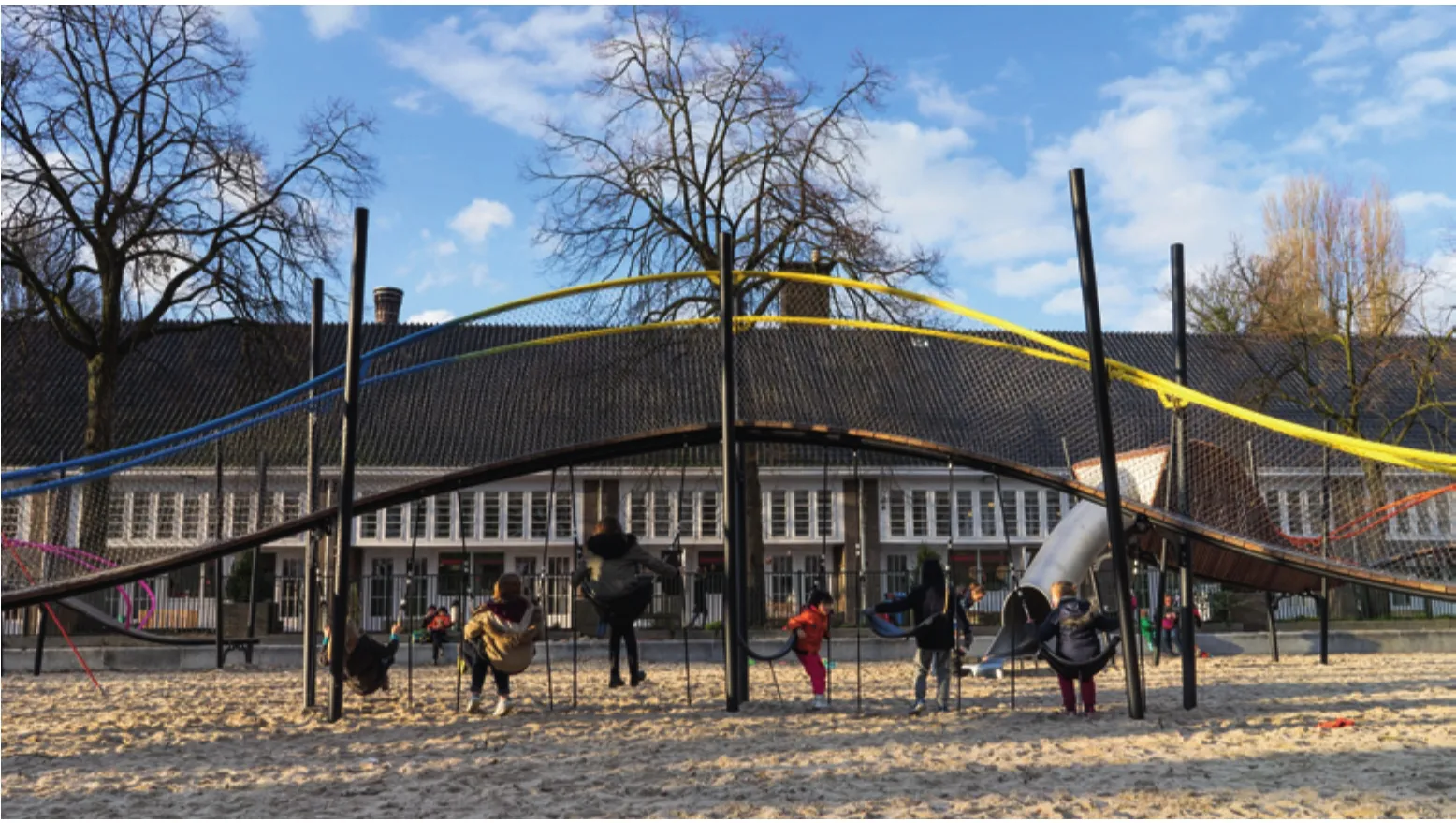
4 拱形构造下方放置着秋千,其独特的造型围合出一个独立的内部空间The object lifts up and creates an 'arch' ,Creates an inner world by its distinctive shape
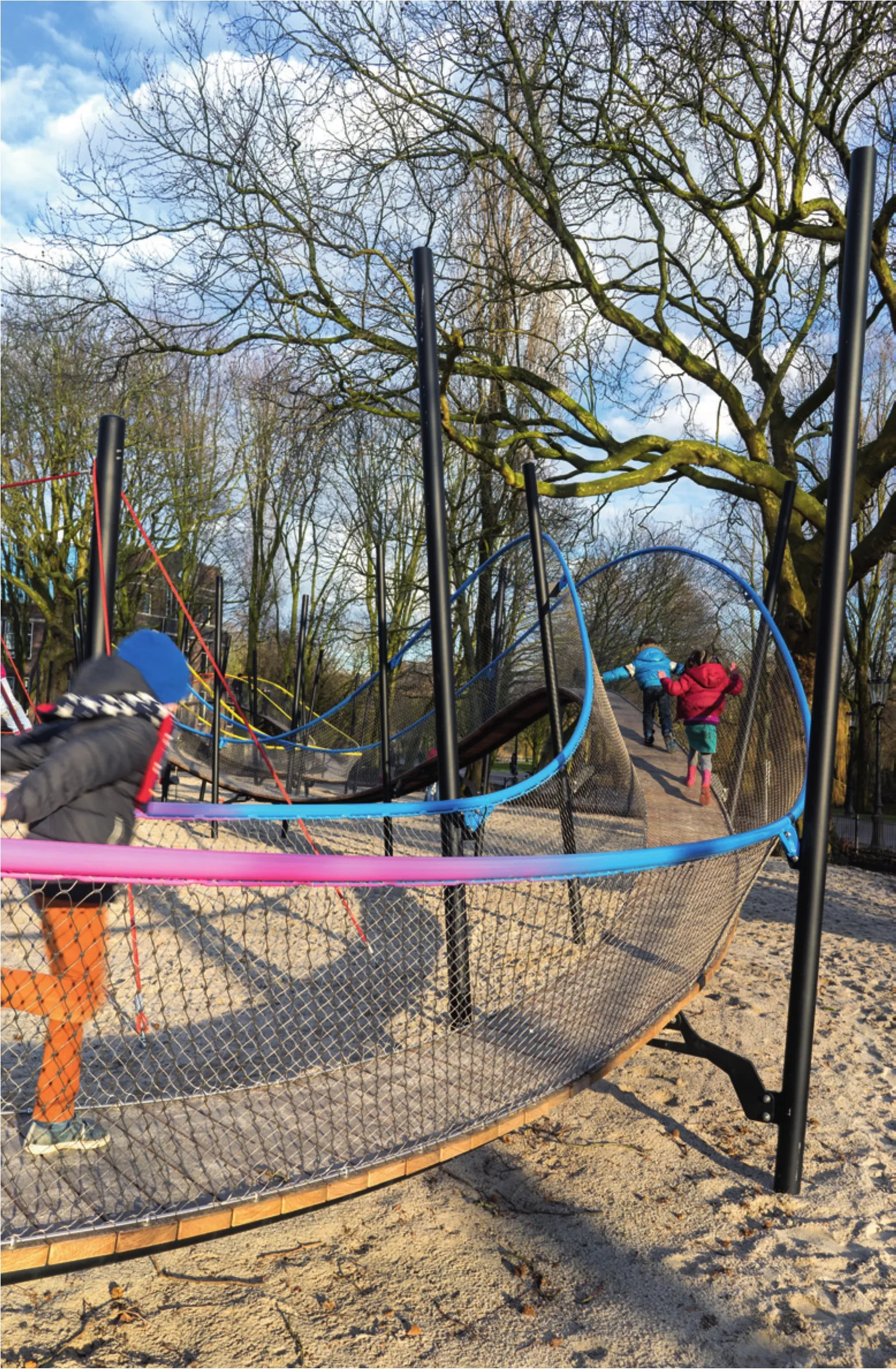
5 时而上升、时而下冲、时而旋转形成狭窄的流线An object that rises up, dives downwards and turns into a narrow line
The Oosterpark, built in 1891, is part of the Amsterdam 19th century extension girdle, and is the first large public park that was realised by the municipality. Landscape architect Leonard Springer designed a classic English landscape style city park with monumental trees, meandering lines and a large water pond. Traditionally, the Oosterpark has been flanked by public functions like the Koninklijk Instituut voor de Tropen, university buildings and the Tropenmuseum - monumental buildings that are located in the northern zone but which 'turn their back' towards the park.
Since 2011, plans are being made to integrate the buildings into the park. This was also the original plan in the 19th century, which was never realised due to budget constraints. In the current situation the monumental buildings are screened off from the park by fences and elevations in the terrain. The new design for the Oosterpark, by Sant en Co, enables the park to extend around these buildings. The fences will be removed, the grass area will be extended and parts of the private property will be added to the public space of the park. As a result, the Oosterpark 'doubles' in size and merges the built and green part of the park into one.
Apart from the physical extension, also the existing park has been upgraded. New path structures were added to improve the structure, the entries have been upgraded and the existing water bodies are enlarged. Additionally, new and existing public park functions were integrated into the park, in harmony with the existing design by Springer.
One of these additions is the 'Play Garland Oosterpark', situated on a former functionless grass field in the north-western corner, in frontof a former open air school. The 88 meter long play garland is an adventurous platform which is transformed to a play structure: an object that rises up, dives downwards and turns into a narrow line -and which creates an inner world by its distinctive shape. The delicate character of the garland adds a new dimension to the play space.

6 游乐环的构造需保持轻盈The play object has been kept very light weight

7 自然材料制造的安全界面,沙子将整个场地营造成了一个具有原始气息游乐场A natural safety surfacing is applied, Sand turns the whole site into a natural play zone
As the canopies and tree roots may not be disturbed, it were the monumental trees that determined the exact location and shape of the object. These parameters also had another advantage: while in cities almost always artificialsafety surfacing is used, in this case a natural safety surfacing could be applied. The play sand, which will not be blown away because of the sheltered setting, is the ultimate playing material and turns the whole site into a play zone. The frailty of the tree roots asked for as little weight as possible, which is why the play object has been kept very light weight; only on a few points it actually touches the ground.
The simplicity of the object invites to run, climb and slide. Because the object rises up in the air considerably at several points, it is a particularly challenging roller-coaster for children between 4-8 years old. Furthermore, the capacity of the play garland is very high; on a busy day, more than hundred children can play simultaneously on and around the object. Depending on age and motor skills, children use the garland in various ways. On the steep parts, the path is also a slide, and on one side the garland transforms into a tube slide. Underneath one of its arches, hammocks are placed, and another section of the platform is divided into two different levels. At the entrances to the site, the object lifts up and creates an 'arch' that opens up towards the inner space. The meandering movement creates a constantly changing perspective, which stimulates the interaction between above and below, and between inside and outside.
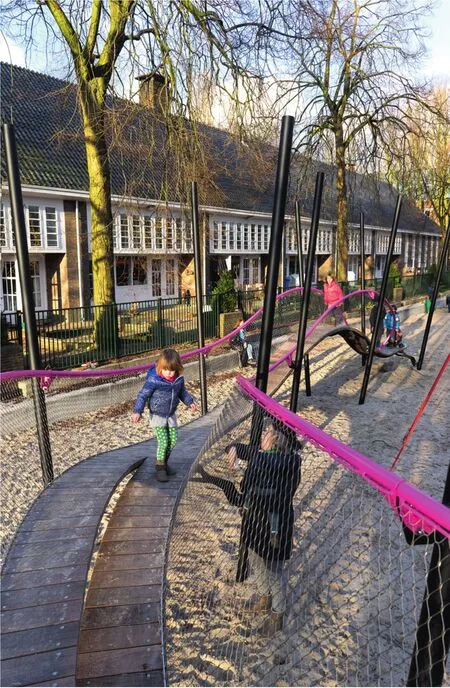
8 游乐设施吸引着孩子们在上面奔跑、攀爬和滑梯The simplicity of the object invites to run, climb and slide
The dominant perception is that play objects should be as colourful as possible. This design tries to unite a dual thought. The main structure of the object is coated in the same colour as all new park elements - anthracite black. As a quip two coloured lines were added, which gradually change their colour. With this, the common 'colour explosion'is reduced to one long, continuous line - by which the object is visible throughout the park as a colour flash, without being dominant.
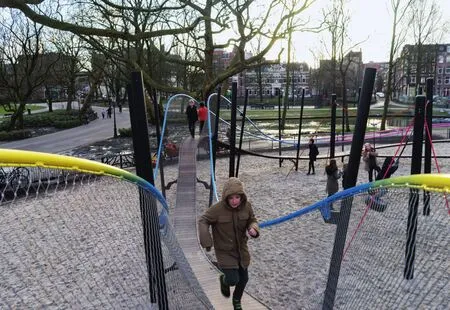
9 游乐设施吸引着孩子们在上面奔跑、攀爬和滑梯The simplicity of the object invites to run, climb and slide.
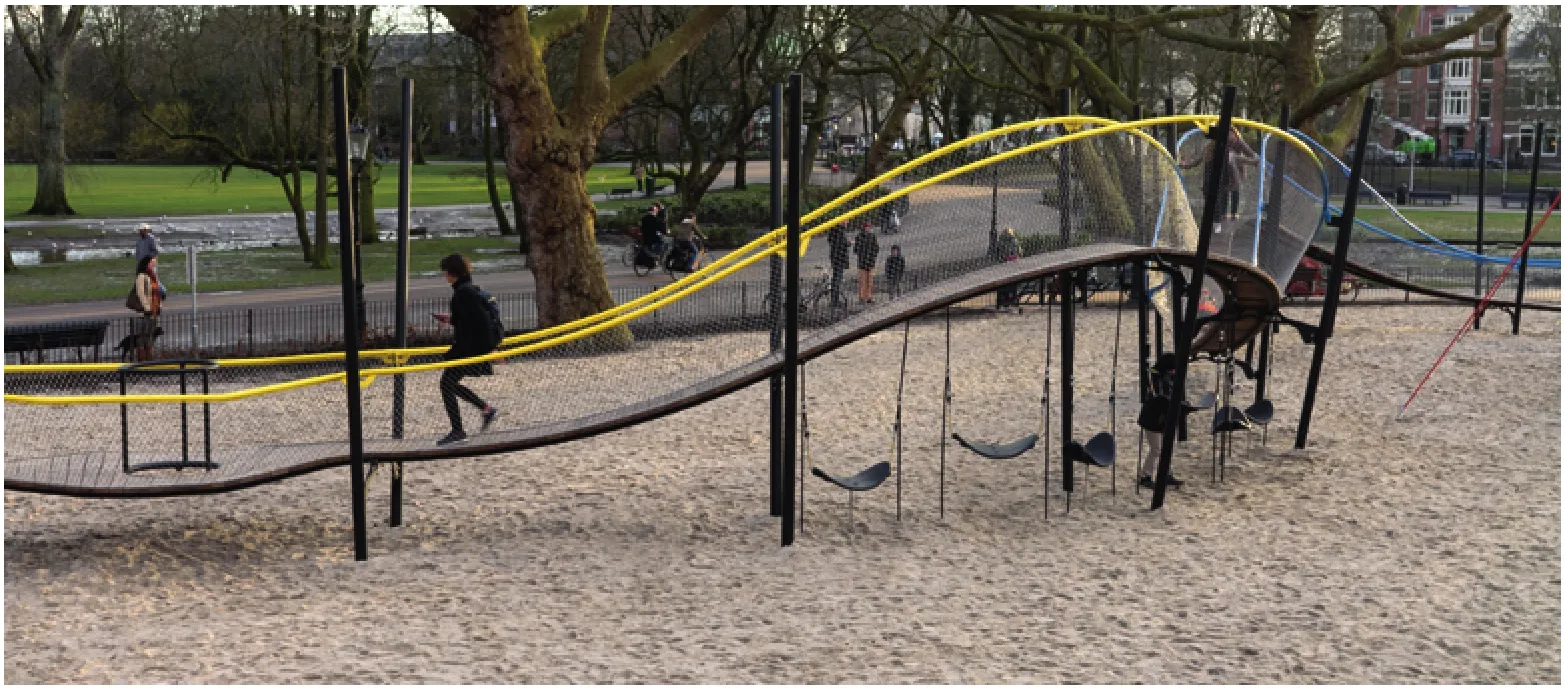
10 结构升起的位置下方形成拱形的空间The object lifts up and creates an 'arch'
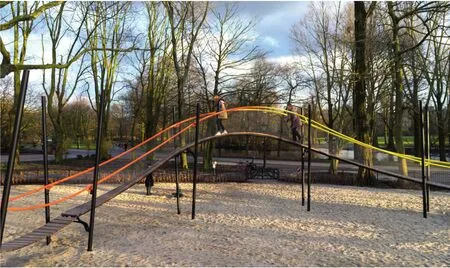
11 陡峭部分的环体形成一个滑梯On the steep parts, the path is also a slide
Time of design: 2012-2015
Time of completion: February 2016
Client: Municipality of Amsterdam
Location: Oosterpark, Amsterdam
Size: 88 meter long play garland
Design team: Carve Landscape Architecture (Elger Blitz, Thomas Tiel Groenestege, Lucas Beukers, Jasper van der Schaaf, Thijs van der Zouwen, Mark van der Eng, Marleen Beek)
Collaboration: Buro Sant en Co landschapsarchitecten
Photography: Carve (Marleen Beek, Jasper van der Schaaf)
Translator: LUO Yu-wei
Proofreading: WANG Xi-yue
Play Garland Oosterpark
Carve Landscape Architecture, Buro Sant en Co landschapsarchitecten

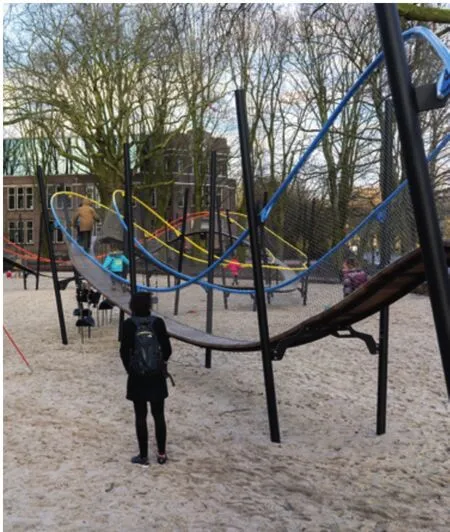
12、13 游乐设施吸引着孩子们在上面奔跑、攀爬和滑梯The simplicity of the object invites to run, climb and slide
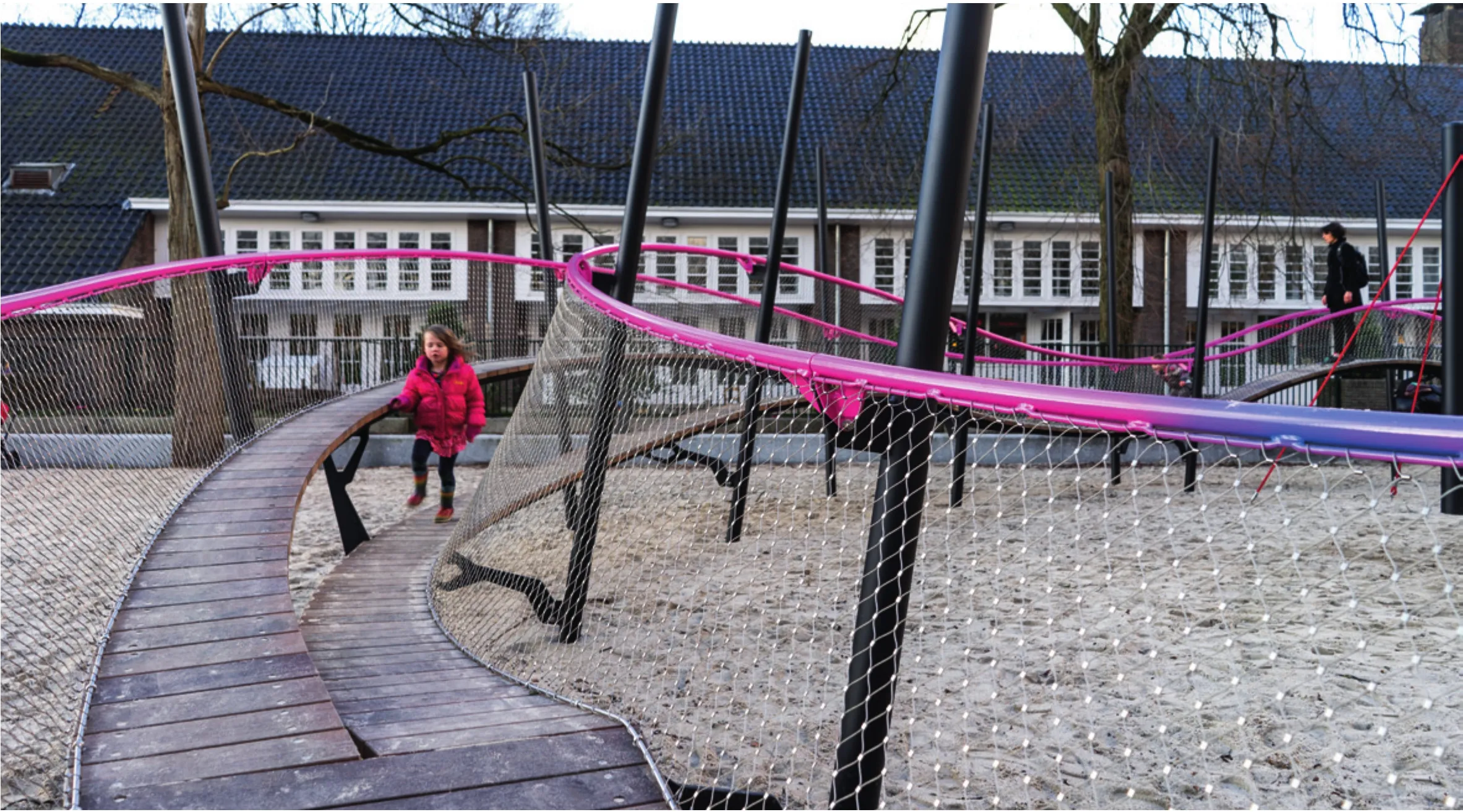
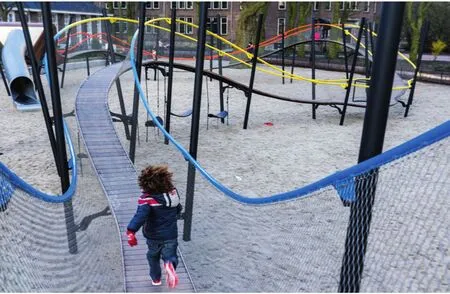
14、15 两条色彩渐变的扶手,以高大乔木的位置为依据确定游乐环的具体位置和形状As a quip two colored lines were added,the monumental trees determined the exact location and shape of the object
